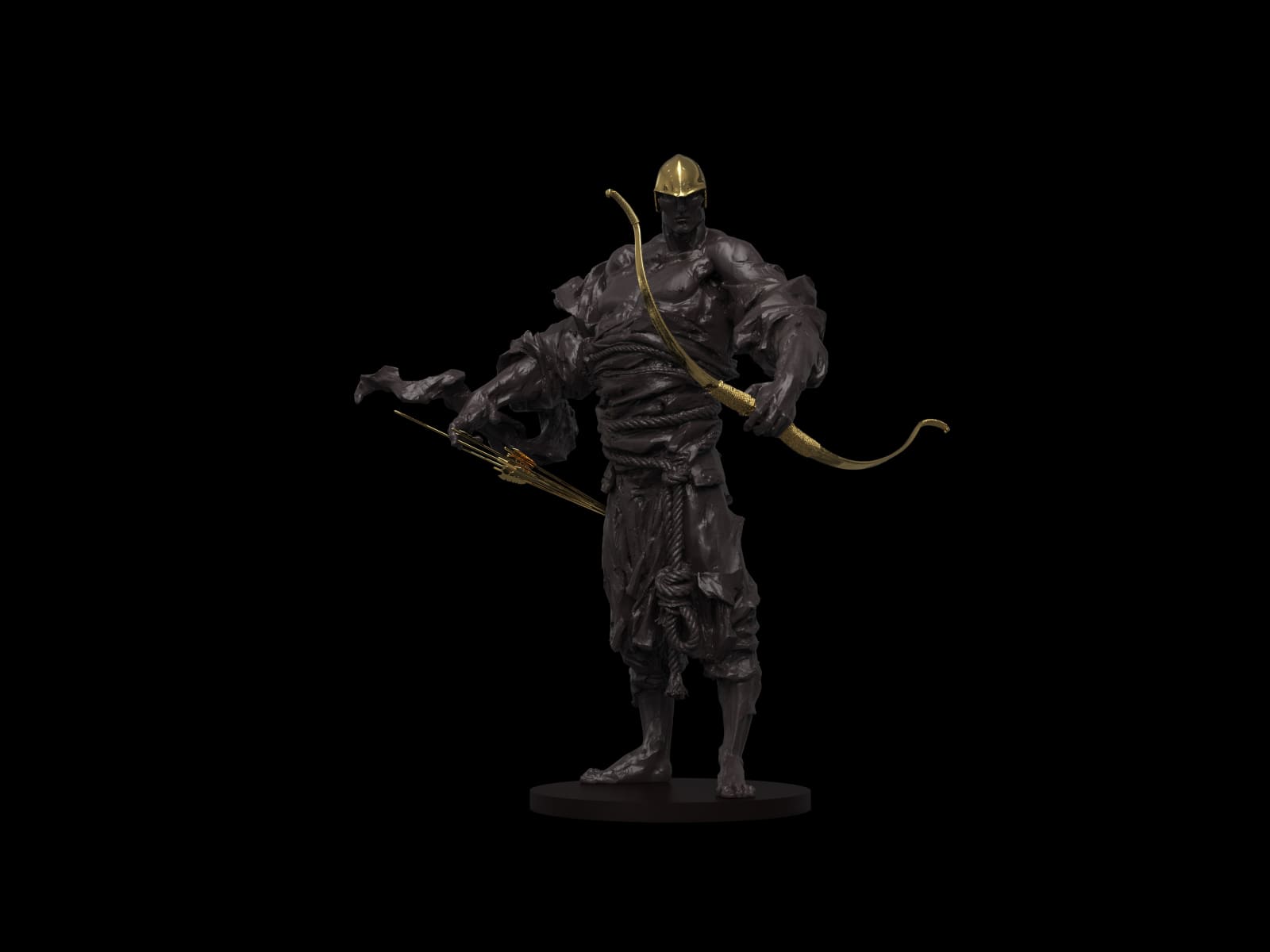Ren Zhe 任哲 China, 1983
Ren Zhe 任哲 China, 1983
White Feathers 尋白羽(M) , 2020
Stainless Steel 不鏽鋼 / Bronze 青銅
75 x 70 x 85 cm (WDH)
Edition of 9 plus 3 artist's proofs
作品「尋白羽」靈感源於唐・盧綸《塞下曲》中,描寫武將李廣的詩句『平明尋白羽,沒在石棱中』 。 整個造型沉穩厚重,充滿文化底蘊同時又不失現代感;將內在不朽的精神與雕塑的藝術語言結合,通過外在的形態傳達精神的力量,最終完美地統一成雕塑的生命力。而這種真實的正是「尋白羽」的靈魂。手上的弓寓意勇往直前,目標明確,願景宏遠;武士渾身閃耀光輝的剪影,被瞬間定格為永恆。羽箭射岀,例不虛發,心中充滿對未來的希望與自信,勇敢面向目標,蓄勢待發,一擊即中。 The inspiration for “White Feather” comes from the Tang Dynasty (618-907) poem by Lu Lun entitled Under a Border Fortress. In this work Li Guang, a general,...
作品「尋白羽」靈感源於唐・盧綸《塞下曲》中,描寫武將李廣的詩句『平明尋白羽,沒在石棱中』 。
整個造型沉穩厚重,充滿文化底蘊同時又不失現代感;將內在不朽的精神與雕塑的藝術語言結合,通過外在的形態傳達精神的力量,最終完美地統一成雕塑的生命力。而這種真實的正是「尋白羽」的靈魂。手上的弓寓意勇往直前,目標明確,願景宏遠;武士渾身閃耀光輝的剪影,被瞬間定格為永恆。羽箭射岀,例不虛發,心中充滿對未來的希望與自信,勇敢面向目標,蓄勢待發,一擊即中。
The inspiration for “White Feather” comes from the Tang Dynasty (618-907) poem by Lu Lun entitled Under a Border Fortress. In this work Li Guang, a general, “finds the white feather at the end of the arrow with the rest embedded in the stone in the morning”.
The form of this work is solid and profound, full of cultural references and yet also contemporary. It combines the inherent and eternal spirit with the artistic language of sculpture, and, at the same time, perfectly conveys the vitality of a unified sculpture through the strength of spirit transferred from the external appearance. The essence of this work captures the soul of the poem “Finding the Arrow”. A statue holding a bow implies that this is a warrior who will never retreat and who has a clear target in mind and an ambitious vision. In this moment in time the silhouette of the shinning military officer becomes eternity. The moment when the arrow leaves the bow and finds its target, symbolises the hope and confidence the figure feels for the future, he is brave and able to face every challenge He is always ready to make every effort to succeed.
整個造型沉穩厚重,充滿文化底蘊同時又不失現代感;將內在不朽的精神與雕塑的藝術語言結合,通過外在的形態傳達精神的力量,最終完美地統一成雕塑的生命力。而這種真實的正是「尋白羽」的靈魂。手上的弓寓意勇往直前,目標明確,願景宏遠;武士渾身閃耀光輝的剪影,被瞬間定格為永恆。羽箭射岀,例不虛發,心中充滿對未來的希望與自信,勇敢面向目標,蓄勢待發,一擊即中。
The inspiration for “White Feather” comes from the Tang Dynasty (618-907) poem by Lu Lun entitled Under a Border Fortress. In this work Li Guang, a general, “finds the white feather at the end of the arrow with the rest embedded in the stone in the morning”.
The form of this work is solid and profound, full of cultural references and yet also contemporary. It combines the inherent and eternal spirit with the artistic language of sculpture, and, at the same time, perfectly conveys the vitality of a unified sculpture through the strength of spirit transferred from the external appearance. The essence of this work captures the soul of the poem “Finding the Arrow”. A statue holding a bow implies that this is a warrior who will never retreat and who has a clear target in mind and an ambitious vision. In this moment in time the silhouette of the shinning military officer becomes eternity. The moment when the arrow leaves the bow and finds its target, symbolises the hope and confidence the figure feels for the future, he is brave and able to face every challenge He is always ready to make every effort to succeed.
展览
「罡」——任哲2017雕塑個人展覽,香港交易廣場
GANG, The Awakened Warrior, Ren Zhe Solo Exhibition 2017, Hong Kong Exchange Square



